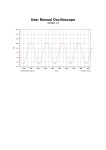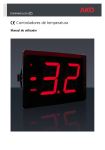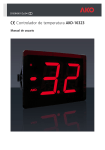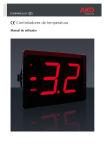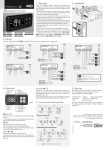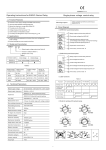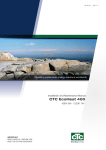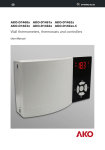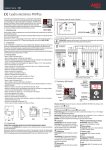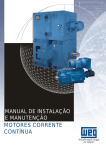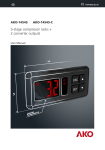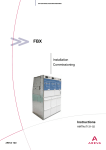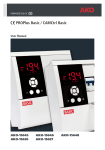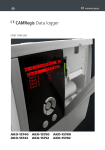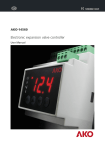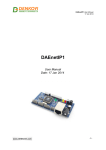Download Temperature controllers
Transcript
D163H002 Ed.04 GB Temperature controllers User Manual Contents Page Chapter 1: Introduction . . . . . . . . . . . . . . . . . . . . . . . . . . . . . . . . . . . . . . . . . . . . . . . . . . . . . . . . . . 3 Chapter 2: Description . . . . . . . . . . . . . . . . . . . . . . . . . . . . . . . . . . . . . . . . . . . . . . . . . . . . . . . . . . . 4 2.1 Keypad functions . . . . . . . . . . . . . . . . . . . . . . . . . . . . . . . . . . . . . . . . . . . . . . . . . . . . . . . . 4 2.2 Display messages . . . . . . . . . . . . . . . . . . . . . . . . . . . . . . . . . . . . . . . . . . . . . . . . . . . . . . . . 5 2.3 Maintenance . . . . . . . . . . . . . . . . . . . . . . . . . . . . . . . . . . . . . . . . . . . . . . . . . . . . . . . . . . . 6 2.4 Precautions . . . . . . . . . . . . . . . . . . . . . . . . . . . . . . . . . . . . . . . . . . . . . . . . . . . . . . . . . . . . 6 Chapter 3: Initial Setup . . . . . . . . . . . . . . . . . . . . . . . . . . . . . . . . . . . . . . . . . . . . . . . . . . . . . . . . . . 6 3.1 Wizard . . . . . . . . . . . . . . . . . . . . . . . . . . . . . . . . . . . . . . . . . . . . . . . . . . . . . . . . . . . . . . . . 6 3.2 Basic settings . . . . . . . . . . . . . . . . . . . . . . . . . . . . . . . . . . . . . . . . . . . . . . . . . . . . . . . . . . . 7 Chapter 4: Operation . . . . . . . . . . . . . . . . . . . . . . . . . . . . . . . . . . . . . . . . . . . . . . . . . . . . . . . . . . . . 8 4.1 Compressor control . . . . . . . . . . . . . . . . . . . . . . . . . . . . . . . . . . . . . . . . . . . . . . . . . . . . . . 8 4.2 Defrost control . . . . . . . . . . . . . . . . . . . . . . . . . . . . . . . . . . . . . . . . . . . . . . . . . . . . . . . . . 10 4.3 Fan control . . . . . . . . . . . . . . . . . . . . . . . . . . . . . . . . . . . . . . . . . . . . . . . . . . . . . . . . . . . . 13 4.4 Light control. . . . . . . . . . . . . . . . . . . . . . . . . . . . . . . . . . . . . . . . . . . . . . . . . . . . . . . . . . . 13 4.5 Alarms . . . . . . . . . . . . . . . . . . . . . . . . . . . . . . . . . . . . . . . . . . . . . . . . . . . . . . . . . . . . . . . 14 Chapter 5: Wiring. . . . . . . . . . . . . . . . . . . . . . . . . . . . . . . . . . . . . . . . . . . . . . . . . . . . . . . . . . . . . . 15 Chapter 6: Parameter setup . . . . . . . . . . . . . . . . . . . . . . . . . . . . . . . . . . . . . . . . . . . . . . . . . . . . . . 16 6.1 Programming Menu . . . . . . . . . . . . . . . . . . . . . . . . . . . . . . . . . . . . . . . . . . . . . . . . . . . . . 16 6.1.1 Changing the operating parameters . . . . . . . . . . . . . . . . . . . . . . . . . . . . . . . . 16 6.1.2 Parameters. . . . . . . . . . . . . . . . . . . . . . . . . . . . . . . . . . . . . . . . . . . . . . . . . . . 17 Chapter 7. Technical Specifications . . . . . . . . . . . . . . . . . . . . . . . . . . . . . . . . . . . . . . . . . . . . . . . . . 21 AKO Electromecanica thanks and congratulates you for purchasing our product, in whose development and manufacture the most innovative technology has been used, as well as strict production and quality control processes. Our commitment to satisfy our customers and our continuous efforts to improve every day can be seen in the various quality certifications we have obtained. This is a high performance, high technology product. The operation and final performance of the equipment depend on proper planning, installation, configuration and commissioning. Read this manual carefully before installation, and always follow its instructions. Only qualified personnel should install or perform technical assistance on this product. This product is designed to be used in the applications described in the product manual. AKO Electromecánica gives no guarantee of its operation in any use not foreseen in the manual, and is not responsible for any damage resulting from improper use, configuration, installation or commissioning. It is the responsibility of the installer and the customer to comply with and ensure others comply with all regulations applicable to installations incorporating our products. AKO Electromecánica is not responsible for any damage caused by non-compliance with regulations. Follow strictly the instructions given in this manual. To maximise the service life of our equipment, these recommendations should be followed: Do not expose electronic equipment to dust, dirt, water, rain, humidity, high temperatures, chemicals or corrosive substances of any sort. Do not submit the equipment to blows or vibrations nor try to manipulate it differently from shown in the manual. Never exceed the specifications and limitations indicated in the manual. Always respect the specified ambient working and storage conditions. During and after installation, avoid leaving loose, broken, unprotected or damaged wiring, since they might constitute a risk for the equipment and its users. AKO Electromecánica reserves the right to make any non-metrology modification to the documentation or the equipment without previous notice. 2 1.- Introduction The Darwin controller range is particularly suitable for controlling refrigerating equipment, wall units, islands, cabinets, electrical panels, etc. The wide range of models available ensures the best solution for each application. The AKO-16323 model has been specially designed for applications requiring a large number of output relays and high power switching. The information displayed on the 2.3" high brightness display can be seen from any angle and from farther away than conventional controllers. New features have been added which allow more efficient refrigeration management, thus saving energy. The menu settings are optimized for fast and intuitive programming and may be pre-programmed according to the application for faster start-up. Application It has three relays and is designed for above- and below-freezing applications, with defrost by resistors or cycle reversal. 3 2.- Description FAN relay active COOL relay active DEF relay active Alarm active Display UP key (N)/SET DOWN key (Q) Terminal blocks Flashing lights indicate that the function in question should be activated by temperature, but is not due to a conflicting timing or protection parameter. 2.1.- Keypad functions Press for 5 seconds to activate Standby mode; press for 2 seconds to return the equipment to normal mode. In Standby mode, the equipment performs no actions and only the AKO indicator is displayed on the screen. Press for 10 seconds to go to the programming menu. Press for 5 seconds in the programming menu to access the level displayed on the screen or, during the setting of a parameter, accepts the new value. In the programming menu, a short press allows you to scroll through the various levels or, during the setting of a parameter, to increment the value. When upper limit is reached, it will start again from the lower limit. Press for 5 seconds to start Fast Freezing mode. In the programming menu, a short press allows you to scroll through the various levels or, during the setting of a parameter, to increment the value. IMPORTANT: If you have configured the access code function as a key lock (P2=2) when you initiate any function (defrost or access to programming) you will be prompted to enter the access code programmed into L5. If the code entered is not correct, the unit will display the temperature without opening the requested function. 4 2.2.- Display messages Flashing 0: Access code (Password) request. You must enter the access code configured on L5 to execute the requested function (p. 8 y 16). See also parameter P2 (p. 20) Probe 1 or 2 faulty (open circuit, crossover or temperature outside the probe limits; NTC: -50 to 99 ºC) Indicates a defrost is underway. After defrosting, the message will continue to be displayed during the time specified in parameter d3 (see Chapter 4.2). Alternative with temperature: Indicates continuous cycle or fast freezing cycle activation (see Section 4.1). Alternative with temperature: Maximum temperature in control probe alarm. Temperature set in A1 has been reached (p. 14 and 15). (activates alarm relay) Alternative with temperature: Minimum temperature in control probe alarm. Temperature set in A2 has been reached (p. 14 and 15). (activates alarm relay) Alternative with temperature: External alarm activated (by digital input) (p. 14 and 15). (activates alarm relay) Alternative with temperature: Severe external alarm activated (by digital input) (p. 14). (activates alarm relay) Alternative with temperature: Defrost alarm time-out. Displayed when a defrost ends after the maximum time elapsed as defined in parameter d1. (p. 11 and 14). (Does not activate alarm relay) Alternative with temperature: Door open alarm. Shown if the door remains open longer than specified in parameter AC (p. 14 and 15). (No activa relé de alarma) Alternative with temperature: ECO mode active 5 2.3.- Maintenance Clean the surface of the alarm using a soft cloth, soap and water. Do not use abrasive detergents, petrol, alcohol or solvents. 2.5.- Precautions Using the equipment without following the manufacturer's instructions may affect the device's safety requirements. To ensure that the device operates correctly, only probes supplied by AKO should be used. The unit must be installed in a location protected from vibrations, water and corrosive gases, where the ambient temperature does not exceed that shown in the technical data. To get a correct reading, the probe must be situated in a location without any external heat influences except for the temperature which is being measured or controlled. The probe and its cable should NEVER be installed in the same conduit as power, control or supply cables. The power supply circuit must be provided with a main switch rated at least 2 A, 230 V, located close to the equipment. The cables will enter through the back and should be type H05VV-F or H05V-K. The gauge will depend on local regulations, but should in no case be less than 1 mm². The cables for connecting the relay contacts should be 1 to 2.5 mm² and the common cable should always be 2.5 mm². Halogen-free cables are recommended. Between -40 ºC and +20 ºC, if the NTC probe is extended up to 1,000 m with minimum 0.5 mm² wire, the maximum deviation will be 0.25 ºC (Wire for probe extension ref. AKO-15586). 3.- Initial Setup 3.1.- Wizard The Darwin range controllers have a setup wizard to configure the main parameters for the type of application chosen (see table). The others will be configured according to the "Def" column in the parameter table (see section 6.1.2). For the meaning of each parameter, see section 6.1.2. This wizard only starts the first time the device is powered. DEFAULT SETTINGS BY APPLICATION (In) SP d0 d1 F0 F3 P0 1 Multipurpose 2ºC (36ºF) 4 20 8ºC (46ºF) 1 0 2 Frozen -18ºC (-0,4ºF) 4 20 0ºC (32ºF) 0 0 3 Fruits and vegetables 10ºC (50ºF) 4 20 30ºC (86ºF) 1 0 4 Fresh fish 0ºC (32ºF) 4 20 8ºC (46ºF) 1 0 5 6 Soft Drinks Bottle Racks 3ºC (37,4ºF) 24 20 8ºC (46ºF) 1 0 12ºC (53,6ºF) 24 20 30ºC (86ºF) 1 0 7 AC 21ºC (69,8ºF) 96 0 99ºC (210ºF) 1 0 WARNING: The default parameters by type of application have been defined for the most common applications. Check that these parameters are suitable for your installation. 6 3.2.- Basic settings Type of inputs The controller has 2 inputs for probes plus 2 digital inputs. The activation of the second probe is defined by parameter P4: P4=1: 1 probe input (S1: Control probe) P4=2: 2 probe inputs (S1: Control probe y S2: Defrost probe). Probe types Parameter P9 permits selecting the type of probes to be connected between NTC (P9=0) and PTC (P9=1). Probe function S1: Temperature control probe, controls temperature of the chamber or cabinet (SP) acting on the COOL relay. S2: Evaporator probe, controls the defrost end temperature (d4) and shuts down the fans (F0). Probe to display Parameter P8 defines which probe is displayed on the controller screen (P8=0 All probes sequentially, P8=1 Probe 1, P8=2 Probe 2) In the sequential mode the screen will display the name of each probe followed by the temperature in each. (S1 - 8,3ºC - S2 - 6,2ºC) Calibrating probe 1 Allows correcting a possible error in probe reading. This can be very useful when you cannot place it in the ideal place. Display mode Parameter P7 sets the display mode for the temperature displayed on the screen (P7=0 No decimals in ºC, P7=1 With a decimal in ºC, P7=2 No decimal degrees in ºF, P7=3, with a decimal in ºF). The changes in this parameter do not affect the operation of the system because the controller automatically calculates equivalent values for the set point, locks, alarms, calibration, etc. Upper/lower blocking of the set point Sets the upper (C2) and lower (C3) thresholds for the set point value (SP). These limits are also valid for automatic variations of the set point (CA and CC). Digital input function The digital input function is defined by parameters PA (D1) and Pb (D2), with the following options: PA/Pb=0: PA/Pb=1: PA/Pb=2: PA/Pb=3: PA/Pb=4: PA/Pb=5: PA/Pb=6: PA/Pb=7: PA/Pb=8: PA/Pb=9: Off (no function) Door contact, controls the activation/deactivation of ECO mode. (p. 9) External alarm, controls activation/deactivation of the external alarm (p. 14). Severe external alarm, controls activation/deactivation of the severe external alarm (p. 14). Slave defrost, activates defrost synchronisation with master uni (p. 11). Activation of the ECO mode by pushbutton, controls activation/deactivation of the ECO mode using an external pushbutton (p. 9). Activation of the fast freezing mode, controls the activation/deactivation of this mode with an external button (p. 8). Not used Defrost activation. You can control the activation/deactivation of the defrost using an external pushbutton connected to the digital input. Activation of the ECO mode by switch, controls activation/deactivation of the ECO mode using an external switch (p.9). 7 gised, and displays a minute count. It is normal single system during the process of start-up or eated system start-ups when tests are carried o Digital input polarity Parameters PC (D1) and Pd (D2), define the polarity of the digital inputs, with the following options: PC/Pd=0: The digital input is energised on closed contact. PC/Pd=1: The digital input is energised on open contact. ntroller will only show the temperature. It will n (alarm, protection of the compressor, etc.) h t by P1. Password Parameter L5 sets a 2-digit access code for accessing certain controller functions. Its functionality is set using the P2 parameter and a choice of several possibilities: P2=0: Inactive access code; password will never by requested. P2=1: Blocks access to parameters; will request access code (L5) when trying to access the program menu. P2=2: Blocks keypad functions; will request the access code (L5) when trying to activate any of the keypad functions (standby, defrost or program menu) Power supply delays Parameter P1 delays all controller functions when energised, and displays a minute count. It is normally used to stagger the start-up of various refrigeration services in a single system during the process of start-up or reset after a period without power. It can also help to avoid repeated system start-ups when tests are carried out on the facility's electrical system. IMPORTANT: During the time set in P1, the controller will only show the temperature. It will not control the system in any way. If additional delays (alarm, protection of the compressor, etc.) have been programmed, they start to run after the period set by P1. 4.- Operation 4.1.- Compressor control NORMAL OPERATION (COOL) When the temperature in probe 1 reaches the set point value (SP) plus the probe differential (C1), the COOL relay is activated, starting the compressor and leading to a drop in temperature. Once you the set point value (SP) is reached, the COOL relay is turned off, stopping the compressor. ON COOL OFF ºC SP SP+C1 FAST FREEZING MODE Commonly used for fast freezing newly stored product. ON COOL OFF SP-CA ºC SP SP+C1 It is activated by an external switch (press once to turn on or off), for which a digital input must be configured as "fast freezing activation" (PA or Pb = 6). Upon enabling this mode, the compressor starts up until the temperature of probe 1 reaches the set point value, plus the change indicated in parameter CA. Then the unit returns to normal operation. If this point is not reached, the unit returns to normal operation after the time set in C9. 8 ECO MODE This mode saves energy during periods in which the refrigeration cabinet is not used much. While this mode is active, the screen will display the message EC. It is activated after a certain period (set in parameter Cb) of cabinet door inactivity, for which one of the digital inputs must be set as "door contact" (PA or Pb = 1). The operation is the same as normal, but increasing the set point by the number of degrees set in parameter CC. ON COOL OFF ºC SP+CC (SP+CC)+C1 Otherwise, users may turn this function on and off at will by pressing an external button (1-touch on/off), for which one of the digital inputs must be set as "ECO mode activation" (PA or Pb = 5). Optionally, you can activate and deactivate this way whenever you want, using an external pushbutton (1 press to activate/deactivate), or using a switch. To do so, one of the digital inputs such as “activation of the ECO mode by pushbutton” (PA or Pb = 5) or “activation of the ECO mode by switch” (PA or Pb = 9) should be configured. If parameter Cb is set to 0, the ECO mode will only activate via switch (PA or Pb=9). COMPRESSOR PROTECTION DELAY There are three types of delay, selectable by parameter C4, to protect the compressor (COOL relay). These delays prevent continuous compressor starts and stops due to sudden changes in temperature. OFF-ON (C4=0): Minimum compressor OFF time before each start-up. OFF-ON / ON-OFF (C4=1): Minimum time during which the compressor will remain ON and OFF in every cycle. The delay time is defined by parameter C5. OPERATION IN CASE OF PROBE 1 FAILURE OFF-ON (C4=0) OFF-ON / ON-OFF (C4=1) ON ON COOL COOL OFF Time SP OFF SP+C1 C5 SP SP+C1 C5 Time C5 In the event of probe 1 failure (fault, disconnection, etc.) compressor performance will depend on C6 settings. Users may choose between 3 options: C6=0: The compressor will be stopped until probe 1 is working again. C6=1: The compressor will be operational until probe 1 is working again. C6=2: The compressor will operate according to the average performance of the last 24 hours, taking into account the number of starts and stops and the average time in each state (stop-start). C6=3: The compressor will run as scheduled in C7 (ON) and C8 (OFF). Probe 1 error (If C6=3) ON COOL OFF Time 9 C7 C8 C7 C8 4.2.- Defrost control The auxiliary relay should be set to "defrost" (P6=1) (default setting), except in the case of defrost by compressor shutdown. default setting), except in the Max. d1 F4 d3 FAN START DELAY CONTROL DEFROST “dE" MESSAGE DRIP TIME CONTROL DEFROST d9 ºC d0 d4 SP+C1 SP time Defrost start-up Defrost is initiated if: -Time scheduled in parameter d0 has passed since the beginning of last defrost. -The DOWN (Q) key is pressed for 5 seconds. Defrost type Selected by parameter d7 to define the controller performance during the defrost process. By compressor shutdown (d7=3) The compressor stops and the defrost takes place statically. Fans will stop running regardless of parameter F3. By air (d7=2) Fans start running and the compressor starts up. Defrost takes place by air being forced through the evaporator. Fans will be on regardless of parameter F3. By resistors (d7=0) The defrost resistors start up and the compressor stops; defrost is the result of heat from the resistors. Fans will be running or not depending on parameter F3. Reverse cycle (Heatpump) (d7=1) A 4-way valve is activated which reverses the cold-generating circuit and the compressor starts up, forcing the defrost. Fans will be running or not depending on parameter F3. By hot gas (d7=1) A valve is actuated which discharges gas from the compressor to the evaporator inlet. A check valve prevents hot gas from returning to the liquid line. Fans will be running or not depending on parameter F3. Drip time Parameter d9 sets drip time and the time added at the end of defrost cycle to allow for drainage of the remaining water in the evaporator. During this time the compressor and fans will not be running (unless defrost is by air). 10 Defrost termination The defrost will terminate if: -The temperature programmed in parameter 24 has been reached in probe 2 (Requires an additional input for the second probe and activates it via parameter P4). -Time set in parameter d1 has passed (maximum duration of defrost). -Press the DOWN (Q) key for 5 seconds. Message displayed during defrost Set by parameter d2, with the choice of showing the actual temperature detected by probe 1 (d2=0), displaying the temperature detected by probe 1 at the start of defrost (d2=1) or displaying the dE message (d2=2). The d3 parameter defines the time during which the message is displayed, once the drip time (D9) and the fan stop time (F4) is over. Other parameters Parameter d5 allows users to specify if the unit will (d5=1) or will not (d5=0) defrost when powered up (initial start-up or after a power failure). In case of choosing option YES (d5=1), the defrost will start after the delay time specified in d6. Using parameter d8, users define the computation of time in d0, choosing between total time elapsed (d8=0) or the total compressor running time (d8=1). NOTE: If parameter d1 is set to 0, no defrost will be performed. Remote defrost Starts or stops the defrost using a pushbutton connected to one of the digital inputs. This input should be configured for this function (PA or Pb=8). Defrost Master - Slave This feature allows users to synchronize defrost of several units. This is especially suitable for cabinets with multiple independently controlled evaporators, thus avoiding having an evaporator defrosting (generating heat) while the next is generating cold. When the main controller configured as Master initiates a defrost, it forces the rest, which must be configured as slaves (PA or Pb=4) to initiate their defrost cycles. When the main controller ends the defrost according to the time set by d1 (the temperature in probe 2 is not taken into account) it will force slaves to end defrosting and start synchronised drip time. The master defrost function can only be set in controllers AKO-D14412, AKO-D14412-RC, AKO-D14423 and AKO-D14423-RC and requires the use of an external relay (see diagram on next page). Up to 15 units may be connected to a Master Controller and the maximum distance should not exceed 15 metres. 11 Example of Master - Slave defrost function AKO-D144xx 1 2 3 AKO-D143xx I max.: 16 A L N Master I max.: 16 A L N Salve 4 5 6 7 8 9 10 11 1 2 3 4 5 6 7 8 9 10 11 DEF DEF S1 Settings: d7=0 P4=2 P6=5 S1 S2 Settings: d7=0 P4=2 P6=1 P10=4 RE S2 AKO-D16323 1 2 3 4 16 A 6A 16 A Slave 5 6 7 8 9 10 11 12 13 Settings: d7=0 P4=2 P6=1 PA=4 S2 AKO-D16323 16 A Slave 1 2 3 4 16 A 6A Maximum distance 15 meters S1 DEF 5 6 7 8 9 10 11 12 13 S1 Settings: d7=0 P4=2 P6=1 PA=4 DEF S2 S1: Control probe S2: Defrost probe (evaporator) RE: External relay to other slave controllers (Maximum 15 controllers) 12 4.3.- Fan control Fan control ON COOL OFF ON Only if F2=1 FAN OFF Time F0 (probe 2) F0+F1 (probe 2) SP SP+C1 The auxiliary relay must be configured as "Fans" (P6=0). Fans are controlled with probe 2 (evaporator) and parameters F0 (shutdown temperature) and F1 (Probe differential). Even if probe 2 is not connected (P4=1) or an error is detected in the probe (E2), the fans will always run regardless of parameters F0 and F1, but taking into account parameters F2 to F5. Parameter F2 defines the status of the fans during compressor stops and parameter F5 defines the status of the fans when the door is opened, which requires setting up one of the digital inputs as door contact (PA or Pb=1). If F5 = Yes, and the door remains opened more than 15 seconds, the compresor also stops. Parameter F3 defines the status of fans during defrost. This feature is activated only for defrost by resistors, cycle reversal or hot gas. If defrost is by air, the fans will always be active and if it is by compressor shutdown they will always be inactive, regardless of parameter F3. Parameter F4 defines the fan start-up delay after defrost (see section 4.2) 4.4.- Light control On units with 2 or more relays, the auxiliary relay can be configured as "Light" (P6=3). In these cases, the AUX relay will remain ON (lights on) while the unit is running. If the unit switches to standby mode, the relay will switch OFF (lights out). This feature turns off the lights in the cabinet when not in use (standby mode). With parameter PJ, the status of the lights can be defined when the device is in ECO mode, except if this mode has been externally activated by switch (PA or Pb=9), in which case, they will always stay on. ers F0 (shutdown temperature) and F1 (Probe diffe s detected in the probe (E2), the fans will alw nt parameters F2 to F5. ressor stops and parameter F5 defines the statu 13 door contact (PA or Pb ne of the digital inputs as ating1 areaches relay* the or both, obe valuewhen set inthe programmed pa erature) parameters. 4.5.- Alarms The unit alerts users via a message on the screen, by activating a relay* or both, when the programmed parameter criteria are met. perature at which the alarm obe 1 reaches the value set in erature) parameters. number of degrees above or ch the alarm is activated. This perature at which the having alarm t the set point without alarm settings. number of degrees above or ysteresis). ch the alarm is activated. This t the set point without having alarm settings. Max/Min Temperature Alarm Shows the AH or AL message when the temperature in probe 1 reaches the value set in the A1 (AH: maximum temperature) and A2 (AL: low temperature) parameters. This value can be: Absolute (A0=1): A1/A2 should indicate the temperature at which the alarm should be activated.. Relative to SP (A0=0): A1/A2 should indicate the number of degrees above or below the set point at which the alarm is activated. This option allows users to adjust the set point without having to modify the high and low alarm settings. Parameter AA sets the differentials for both parameters (hysteresis). This alarm will also activate the auxiliary relay (if P6=2). Example In a controller we configure the following parameters: SP=2, A1=10, AA=2 - If A0=0 (relative to SP), the maximum temperature alarm goes off when probe 1 reaches 12 degrees and is disabled when it reaches 10 degrees. - If A0=1 (absolute), the maximum temperature alarm goes off when probe 1 reaches 10 degrees and is disabled when it reaches 8 degrees. External alarm/severe external alarm Displays the message AE (external alarm) or AS (severe external alarm), when the digital input configured as external alarm or severe external alarm is activated. The severe external alarm also deactivates all the charges, therefore, the temperature regulation is stopped. When this alarm disappears the device returns to its normal operation. At least one of the digital inputs must be configured as external alarm (PA or Pb=2) or severe external alarm (PA or Pb=3). This alarm will also activate the auxiliary relay (if P6=2). Defrost alarm completed by time Shows the Ad alarm message when a defrost terminates by time-out, if parameter A8=1. This alarm is only displayed on the screen; it will never activate the alarm relay. ysteresis). ers: SP=2, A1=10, AA=2 ure alarm goes off when probe 1 reaches 12 deg Alarma de puerta abierta Displays PA message when the digital input configured as door contact (PA or Pb=1), is active longer than the time set by parameter AC. This alarm is only displayed on the screen; it will never activate the alarm relay. alarm goes A1=10, off whenAA=2 probe 1 reaches 10 degree ers: SP=2, ure alarm goes off when probe 1 reaches 12 deg *The AUX relay must be configured as an alarm (P6=2). 14 alarm goes off when probe 1 reaches 10 degree xternal alarm), when the digital Alarm delay These delays prevent the display of specific alarms while allowing the unit to recover normal operation after certain events. -Start-up delays (A3): Delays activation of temperature alarms on power-up (start-up or after a power failure). This allows avoiding continuous alarms upon start-up -Delay after defrost (A4): Delays activation of temperature alarms post-defrost. -Delay of max/min temperature alarm (A5): Delays activation of maximum (A1) and minimum (A2) temperature alarms from the moment temperature probe 1 reaches the set value. -Delay of external alarm / severe external alarm activation (A6): Delays the activation of the external alarm from the moment the digital input becomes active. -Delay of external alarm / severe external alarm deactivation (A7): Delays the deactivation of the external alarm from the moment the digital input becomes inactive. -Door opening alarm relay (AC): Delays activation of the open door opening detection alarm. Alarm relay configuration If the auxiliary relay is configured as an alarm relay (P6=2), parameter A9 allows defining the status of the relay when an alarm is triggered. A9=0 relay active (ON) in case of alarm (no alarm OFF); A9=1 Inactive relay (OFF) in case of alarm (no alarm ON) 5.- Wiring I max.: 16 A L N 6 7 8 9 10 11 12 13 S1 5 S2 4 DI1 3 DI2 2 90-240 V~ 50/60 Hz 1 16 A 6A 16 A AKO-D16323 FAN AUX AUX. R. HEATER AUX. AUX Operationg according to P6 S1: Probe 1, chamber or furniture temperature. S2: Probe 2, defrost. DI1/DI2: Digital input 1 / Digital input 2 COOL 15 6.- Parameter setup Through the programming menu users can set different parameters to adjust the operation of the controller to the needs of your installation. 6.1.- Programming Menu To access the programming menu, press the UP/SET button for 10 seconds, or until the "PR" appears on the screen. IMPORTANT: If the access code function has been set as keypad lock (P2=2) or as parameter access block (P2=1), when trying to access either of the two functions, users will be prompted to enter the access code programmed in L5. If the code entered is not correct, the unit will revert to displaying the temperature. 5 sec. Temperature Indication Keep pressed UP/ SET 10 sec. Release UP/SET to go to Stand-by t Release UP/SET to access programming 6.1.1.- Changing the operating parameters Press the UP/SET button for 10 seconds or until "Pr" appears on the screen. After 20 seconds with no key being pressed, the equipment will return to the previous level. If you are on level 3, the changes will not be saved. OUT OF PROGRAMMING PROGRAMMING Level 1 Menus Press UP/ SET >10 sec. OK Press UP/ SET >5 sec. Level 2 Parameters OK Press UP/ SET >5 sec. Change Value Press UP/ SET <5 sec. Change Parameters Press UP/ SET <5 sec. Change Menu Press UP/ SET <5 sec. OK Press UP/ SET >5 sec. OK Press UP/ SET >5 sec. 16 Level 3 Values Save changes Temperature Indication 20 sec. OK Press UP/ SET >5 seg. 20 sec. Don’t save changes 20 sec. 6.1.2.- Parameters The unit's operation parameters are organized into groups or families according to their function. The def. column shows factory-set default parameters. Those marked with an * are variable depending on the application chosen in the wizard (see section 3.1). Temperature values are expressed in ºC. (Equivalent temperature in ºF) Level 2 Level 1.- Regulation and Control Values Min Def Max. SP Temperature Adjustment (Set Point) (limits depending on probe type) (Page 8) Description (ºC/ºF) -50 * 99 C0 Calibrating probe 1 (Offset) (Page 7) (ºC/ºF) -20 0.0 20 C1 Probe 1 differential (Histeresis) (Page 8) (ºC/ºF) 0.1 2.0 20 C2 Upper blocking of the set point (Page 7) (cannot be set below this value) (ºC/ºF) C3 99 99 C3 Lower blocking of the set point (Page 7) (cannot be set below this value) (ºC/ºF) -50 -50 C2 0 0 1 0 0 99 0 2 3 Type of delay for protection of the compressor (relay COOL) (Page 9): C4 0=OFF/ON (since the last disconnection); 1=OFF-ON/ON-OFF (since the last shut-down/start-up) C5 Protection delay time (value od the option selected in parameter C4) (Page 9) (min.) Status of COOL relay with probe 1 fault (Page 9): C6 0=OFF; 1=ON; 2=Average based on last 24 hours prior to probe fault; 3=ON-OFF as prog. C7 and C8 C7 Time relay ON in case of faulty probe (Page 9): (If C7=0 and C8¹0, the relay will always be OFF deenergised) (min.) 0 10 99 C8 Time relay OFF in case of fault of probe 1 (Page 9) (If C8=0 and C7¹0, the relay will always be OFF deenergised) (min.) 0 5 99 (h.) 0 24 48 (ºC/ºF) 0 -50 C3-SP (h.) 0 2 24 (ºC/ºF) 0 2 C2-SP C9 Maximum duration of fast freezing mode. (0=off) (Page 8) Chagne set point (SP) in fast freezing mode, when it reaches this point (SP+CA),returns to CA normal (Page 8) (SP+CA ³ C3) (0=OFF) The vaule of this parameter is always negative, excepto if it is 0 Cb Length of inactivity at digital input to activare ECO mode (Only if PA or Pb =1) (0=OFF) (Page 9) CC Change set point (SP) in ECO mode (SP+CC£ C2) (0= off) (Page 9) EP Exit to Level 1 17 Level 2 Level 1.- Defrost Control Values (h.) Min Def Max. d0 Defrost frequency (Time between two starts) (Page 10) 0 96 d1 Maximum defrost duration (0=defrost deactivated) (Page 11) (min.) 0 * * 0 2 2 d2 Description Type of message during defrost (Page 11) 0=Current temperature; 1=Temperature at start of defrost; 2=Display dE message 99 d3 Maximum duration of message (Page 11) (min.) 0 5 99 d4 Defrost end temperature (Probe 2) (If P4 = 2) (Page 11) (ºC/ºF) -50 8 99,9 0 0 1 0 0 99 0 0 3 0 0 1 (min.) 0 1 99 d5 Defrost on equipment start-up (Page 11): 0=NO, First defrost as per d0; 1=YES, First defrost as per d6 d6 Defrost start delay on equipment start-up (Page 11) Defrost type: d7 (Page 10) 0=Resistors; 2=Fan/air; (min.) 1=Reverse cycle 3= Compressor shutdown d8 Calculated time between defrost period (Page 11): 0=Total actual time; 1 =Sum of times the compressor is on d9 Drip time at end of defrsot (Page 10) (compressor and fans off) (If P4 = 2) EP Exit Level 1 Level 2 Level 1.- Fan Control Values Min Def Max. F0 Fan shut-down temperature as per probe 2 (If P4 = 2) (Page 13) Description (ºC/ºF) -50 * 99 F1 Probe 2 differencial (If P4 = 2) (Page 13) (ºC/ºF) 0,1 2,0 20 F2 Stop fans when stopping compressor 0=No; 1=Yes (Page 13) 0 1 1 F3 Fan status during defrost (Page 13) 0=Off; 1=On 0 * 1 0 3 99 0 0 1 F4 Starting delay after defrost (If F3=0) (Page 13) Will only operate if it is higher than d9 F5 Stops fans on opening the door 0=No; 1=Yes (Page 13) (Requires a digital input configured as port PA or Pb=1) (min.) EP Exit Level 1 18 Level 2 Level 1.- Alarm control Description Values A0 Configuration of temperature alarms (Page 14) 0=Relative to SP; 1=Absolute Min Def 0 0 Max. 1 A1 Maximum alarm probe 1 (must be greater then SP) (Page 14) (ºC/ºF) A2 99 99 A2 Minumum alarm probe 1 (must be greater then SP) (Page 14) (min.) -50 -50 A1 A3 Temperature alarm delay during start-up (Page 15) (min.) 0 0 99 A4 Temperature alarm delay after completion of a defrost (Page 15) (min.) 0 0 99 Temperature alarm delay after reaching the A5 value of A1 or A2 (Page 15) (min.) 0 30 99 A6 External alarm / severe external alarm delay when receiving digital input signal (PA or Pb=2 or 3) (Page 15) (min.) 0 0 99 A7 Deactivation delay of the external alarm / severe external alarm when the signal of the digital input disappears (PA or Pb=2 or 3) (Page 15) (min.) 0 0 99 A8 Show warning if defrost is terminated by time-out 0=No; 1=Yes (Page 14) 0 0 1 Alarm relay polarity A9 (Page 15) 0 0 1 0= Relay ON in alarm (OFF no alarm); 1= Relay OFF on alarm (ON with no alarm) AA Temperature Alarm Differential (A1 and A2) (Page 14) (ºC/ºF) 0,1 1,0 20 AC Door open alarm delay (If PA or Pb = 1) (Page 15) (min.) 0 2 99 EP Exit to Level 1 19 Level 2 Level 1.- General status Description Values Min Def Max. (min.) 0 0 99 0 0 2 P4 Selection of type of inputs: 1=1probe 2=2 probes (Page 7) 1 1 2 P5 MODBUS address (only systems with built-in communications) 1 1 99 P6 Configuration of AUX relay: 1=Defrost; 2=Alarm; 3=Light (Pages 10 to 15) 0 1 3 Temperature display mode (Page 7) 0= Whole in ºC 1=One decimal in ºC P7 2=Whole in ºF 3=One decimal in ºF 0 1 3 0 1 2 0 0 1 P1 Daley of all functions on receiving electrical power (Page 8) P2 P8 Access code (password) functions (Page 8) 0= Inactive; 1= Block access to parameters; 2= Keyboard lock Probe to be displayed (as per parameter P4) (Page 7) 0=Visualization of all the probes in sequence; 1=Probe 1; 2=Probe 2 P9 Selection of probe type 0=NTC; 1=PTC (Page 7) Configuring digital input 1 (Page 7) 0=Off 1=Door contact 4=Slave defrost PA 3=Severe external alarm 6=Act. Fast Freezing (If C9 ¹0) 7=Not used 9=Act. ECO mode by switch 2=External Alarm 5=Act. ECO mode by pushbutton 8=Remote defrost 0 0 9 Configuring digital input 2 (Page 7) 0=Off 1=Door contact 4=Slave defrost Pb 3=Severe external alarm 6=Act. Fast Freezing (If C9 ¹0) 7=Not used 9=Act. ECO mode by switch 2=External Alarm 5=Act. ECO mode by pushbutton 8=Remote defrost 0 0 9 PC Digital input polarity 1: 0=Energised on closed contact; 1=Energised on open contact (Page 7) 0 0 1 Pd Digital input polarity 2: 0=Energised on closed contact; 1=Energised on open contact (Page 7) 0 0 1 PJ Lights in ECO Mode (P6=3) 0=ON; 1=OFF (1) 0 0 1 Min Def Max. 0 - 99 EP Exit Level 1 (1): Without effect in the event of activation of the ECO mode by switch. Level 2 Level 1.- Access control and information (ti) Description Values L5 Access code (Password) (Pág.8) PU Program version (Information) - Pr Program revision (Information) EP Exit Level 1 - 20 7.- Especificaciones técnicas Power supply . . . . . . . . . . . . . . . . . . . . . . . . . . . . . . . . . . . . . . . . . . . . . . . . . . . . . . . . . . . . . 90-240 V ~ 50/60 Hz 7 VA Maximum Voltage SELV circuits . . . . . . . . . . . . . . . . . . . . . . . . . . . . . . . . . . . . . . . . . . . . . . . . . . . . . . . . . . . . . . . . . 20 V nputs (According to P4) . . . . . . . . . . . . . . . . . . . . . . . . . . . . . . . . . . . . . . . . . . . . . . . . 2 inputs NTC/PTC + 2 digital inputs Relay 16 A (COOL) . . . . . . . . . . . . . . . . . . . . . . . . . . . . . . . . . . . . . . . . . . . . . . . . . . . . . . . . (EN60730-1: 12(9) A 250 V~) Relay 6 A (FAN) . . . . . . . . . . . . . . . . . . . . . . . . . . . . . . . . . . . . . . . . . . . . . . . . . . . . . . . . . . . (EN60730-1: 5(4) A 250 V~) Relay 8 A (AUX) . . . . . . . . . . . . . . . . . . . . . . . . . . . . . . . . . . . . . . . . . . . . . . . . . . . . . . . . . . . (EN60730-1: 8(4) A 250 V~) Number of relay operations . . . . . . . . . . . . . . . . . . . . . . . . . . . . . . . . . . . . . . . . . . . . . . . EN60730-1: 100.000 operations Types of probe . . . . . . . . . . . . . . . . . . . . . . . . . . . . . . . . . . . . . . . . . . . . . . . . . . . . . NTC AKO-149xx / PTC AKO-1558xx Measurement range . . . . . . . . . . . . . . . . . . . . . . . . . . . . . . . . . . . . . . . . . . . . . . . . . . . . . -50 ºC to +99 ºC (-58 ºF to 99 ºF) Resolution . . . . . . . . . . . . . . . . . . . . . . . . . . . . . . . . . . . . . . . . . . . . . . . . . . . . . . . . . . . . . . . . . . . . . . . . . . . . . . . 0,1 ºC Working environment . . . . . . . . . . . . . . . . . . . . . . . . . . . . . . . . . . . . . . . . . . . . . . . . . . . . . . -10 to55 ºC, humidity <90 % Ambient storage humidity . . . . . . . . . . . . . . . . . . . . . . . . . . . . . . . . . . . . . . . . . . . . . . . . . . . -30 to 70 ºC, humidity <90 % Class of protection - frontal panell . . . . . . . . . . . . . . . . . . . . . . . . . . . . . . . . . . . . . . . . . . . . . . . . . . . . . . . . . . . . . . . IP40 Fixation . . . . . . . . . . . . . . . . . . . . . . . . . . . . . . . . . . . . . . . . . . . . . . . . . . . . . . . . . . . . . . . . Panel-mounted with anchors Panel cutout dimensions . . . . . . . . . . . . . . . . . . . . . . . . . . . . . . . . . . . . . . . . . . . . . . . . . . . . . . . . . . . . . . . . 124 x 85 mm Front panel dimensions . . . . . . . . . . . . . . . . . . . . . . . . . . . . . . . . . . . . . . . . . . . . . . . . . . . . . . . . . . . . . . . . 139 X 100 mm Depth . . . . . . . . . . . . . . . . . . . . . . . . . . . . . . . . . . . . . . . . . . . . . . . . . . . . . . . . . . . . . . . . . . . . . . . . . . . . . . . . . . 40 mm Connections . . . . . . . . . . . . . . . . . . . . . . . . . . . . . . . . . . . . . . . . . . . . . . . . . . . . Screw terminals for cables up to 2.5 mm² Rating of control device: built-in, automatic operation feature Type 1.B, for use in clean environments, Class A software and continuous operation. Pollution classification 2 s/ UNE-EN 60730-1. Double insulation between supply, secondary circuit and relay output. Rated pulse voltage . . . . . . . . . . . . . . . . . . . . . . . . . . . . . . . . . . . . . . . . . . . . . . . . . . . . . . . . . . . . . . . . . . . . . . . . 2500 V Temperature during ball-pressure test Accessible parts . . . . . . . . . . . . . . . . . . . . . . . . . . . . . . . . . . . . . 75 ºC Parts which position active elements . . . . . . . . . . . . . . . . . . . . . 125 ºC Voltage and current as per EMC tests . . . . . . . . . . . . . . . . . . . . . . . . . . . . . . . . . . . . . . . . . . . . . . . . . . . . . . . . . 207 V, 17 mA Current of radio jamming supression tests . . . . . . . . . . . . . . . . . . . . . . . . . . . . . . . . . . . . . . . . . . . . . . . . . . . . . . . 270 mA 21 22 23 Updated information on our website: www.ako.com 35D144002 REV.03 2014 AKO ELECTROMECÁNICA, S.A.L. Av. Roquetes, 30-38 | 08812 Sant Pere de Ribes | Barcelona | España Tel. (34) 938 142 700 | Fax (34) 938 934 054 | e-mail: [email protected] | www.ako.com
























